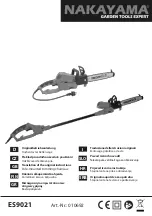
-33-
D('(*Fne\ijDXelXcD]^%J`eZ\-&'0
G8
I
K
J
GIF9C<D
GFJJ@9C<:8LJ<
:FII<:K@M<8:K@FE
Blades break often.
1. Blade is not tensioned correctly.
2. The workpiece is loose in the vise.
3. The feed or cut speed is wrong.
4. The blade TPI is too great, or the
material is too coarse.
5. The blade is rubbing on the wheel
flange.
6. The bandsaw is being started
with the blade resting on the
workpiece.
7. The guide bearings are misaligned,
or the blade is rubbing on the
wheel flange.
8. The blade is too thick, or the
blades are of low quality.
1. Check to see that blade is not excessively tight or
too loose.
2. Clamp the workpiece tighter, or use a jig to hold the
workpiece.
3. Refer to
Feed Rate
on
Page 25
, or
Blade Speed
on
Page 23
, and adjust as required.
4. Refer to
Blade Selection
on
Page 24
and adjust as
required.
5. Refer to
Blade Tracking
on
Page 29
, and adjust as
required.
6. Start bandsaw and then slowly lower the headstock
by setting the feed rate.
7. Refer to
Blade Tracking
on
Page 29
, or
Blade Guides
on
Page 19
and adjust as required.
8. Use a higher quality blade.
Blade dulls prematurely.
1. The cutting speed is too fast.
2. The blade TPI is too coarse.
3. The blade feed pressure is too
light.
4. The workpiece has hard spots,
welds, or scale is on the material.
5. The blade is twisted.
6. The blade is slipping on the
wheels.
1. Refer to
Blade Speed
on
Page 23
, and adjust as
required.
2. Refer to
Blade Selection
on
Page 24
, and adjust as
required.
3. Refer to
Feed Rate
on
Page 25
, and adjust as
required.
4. Increase the feed pressure, and reduce the cutting
speed.
5. Replace the blade.
6. Refer to
Blade Tension
on
Page 18
, and adjust as
required.
Blade wears on one side.
1. The blade guides are worn or mis-
adjusted.
2. The blade guide slide bracket is
loose.
3. The wheels are out of alignment.
1. Refer to
Blade Guides
on
Page 19
and replace or
adjust.
2. Tighten the blade guide bracket.
3. Refer to
Blade Tracking
on
Page 29
, and adjust as
required.
Teeth are ripping from the
blade.
1. The feed pressure is too heavy and
the blade speed is too slow; or
the blade TPI is too coarse for the
workpiece.
2. The workpiece is vibrating in the
vise.
3. The blade gullets are loading up
with chips.
1. Refer to
Blade Selection
on
Page 24
and decrease
the feed pressure. Refer to
Feed Rate
on
Page 25
,
and adjust as required.
2. Re-clamp the workpiece in the vise, and use a jig if
required.
3. Use a coarser-tooth blade.
Summary of Contents for SHOP FOX M1013
Page 36: ...34 D Fne i j DXelXc D J eZ 0 G8IKJ G8IKJ Dfkfi IXk fekifc 8 0 8 0 0 0 8 8 8...
Page 38: ...36 D Fne i j DXelXc D J eZ 0 G8IKJ JXn 8jj dYcp 8 0 0 0 0 8 0 J GX J GX J GX J GX J GX...
Page 40: ...38 D Fne i j DXelXc D J eZ 0 G8IKJ JkXe 8jj dYcp 0 0 08 8 8 8 8...
Page 42: ...40 D Fne i j DXelXc D J eZ 0 G8IKJ l j J_X kj 0 0 0 0 0 M M M 0 M 0 guides and shafts...
Page 45: ...D Fne i j DXelXc D J eZ 0...














































